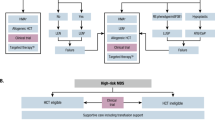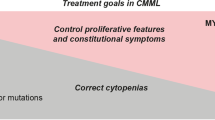Abstract
Myelodysplastic syndromes (MDS) are a heterogeneous group of hematopoietic stem cell disorders. Although the currently used classification schemes and prognostic algorithms, which are based predominantly on morphologic assessment of blood and marrow smears, have been shown to be valid for defining disease subgroups, they do not take into consideration the significant biological diversity of MDS. As the numerous pathophysiologic pathways that are involved in MDS are being unraveled, new molecular targets are being identified. Novel and targeted therapeutic agents, including inhibitors of farnesyltransferases and receptor tyrosine kinases, more potent thalidomide analogs and epigenetic therapies, have produced encouraging results and might offer durable benefits to patients with MDS. This review intends to provide a concise report on some of the most up-to-date therapies being investigated in MDS.
This is a preview of subscription content, access via your institution
Access options
Subscribe to this journal
Receive 12 print issues and online access
$209.00 per year
only $17.42 per issue
Buy this article
- Purchase on Springer Link
- Instant access to full article PDF
Prices may be subject to local taxes which are calculated during checkout
Similar content being viewed by others
References
Heaney ML and Golde DW (1999) Myelodysplasia. N Engl J Med 340: 1649–1660
Steensma DP and Tefferi A (2003) The myelodysplastic syndrome(s): a perspective and review highlighting current controversies. Leuk Res 27: 95–120
Faderl S and Kantarjian HM (2004) Novel therapies for myelodysplastic syndromes. Cancer 101: 226–241
Aul C et al. (1998) Increasing incidence of myelodysplastic syndromes: real or fictitious? Leuk Res 22: 93–100
Germing U et al. (2004) No increase in age-specific incidence of myelodysplastic syndromes. Haematologica 89: 905–910
Park DJ and Koeffler HP (1996) Therapy-related myelodysplastic syndromes. Semin Hematol 33: 256–273
Estey EH (1998) Prognosis and therapy of secondary myelodysplastic syndromes. Haematologica 83: 543–549
Albitar M et al. (2002) Myelodysplastic syndrome is not merely “preleukemia”. Blood 100: 791–798
Rosenfeld C and List A (2000) A hypothesis for the pathogenesis of myelodysplastic syndromes: implications for new therapies. Leukemia 14: 2–8
Mufti GJ (2004) Pathobiology, classification, and diagnosis of myelodsyplastic syndromes. Best Prac Res Clin Haematol 17: 543–557
Barrett J et al. (2000) Myelodysplastic syndrome and aplastic anemia: distinct entities or diseases linked by a common pathophysiology? Semin Hematol 37: 15–29
Allampallam K et al. (2001) Cytokines and MDS. Cancer Treat Res 108: 93–100
Killick SB et al. (2003) A pilot study of antithymocyte globulin (ATG) in the treatment of patients with 'low-risk' myelodysplasia. Br J Haematol 120: 697–684
Lancet JE and Karp JE (2003) Farnesyltransferase inhibitors in hematologic malignancies: new horizons in therapy. Blood 102: 3880–3889
Hofmann W-K et al. (2002) Characterization of gene expression of CD34+ cells from normal and myelodysplastic bone marrow. Blood 100: 3553–3560
Giagounidis AA et al. (2004) The 5q- syndrome. Hematology 9: 271–277
Bennett JM et al. (1982) Proposals for the classification of the myelodysplastic syndromes. Br J Haematol 51: 189–199
Harris NJ et al. (1999) World Health Organization classification of neoplastic diseases of the hematopoietic and lymphoid tissues: report of the Clinical Advisory Committee meeting, Airlie House, Virginia, November 1977. J Clin Oncol 17: 3835–3849
Nösslinger T et al. (2001) Myelodysplastic syndromes, from French-American-British to World Health Organization: comparison of classification on 431 unselected patients from a single institution. Blood 98: 2935–2941
Howe RB et al. (2004) The WHO classification of MDS does make a difference. Blood 103: 3265–3270
Greenberg P et al. (1997) International scoring system for evaluating prognosis in myelodysplastic syndromes. Blood 89: 2079–2088
[No authors listed] (1998) NCCN practice guidelines for the myelodysplastic syndromes. National Comprehensive Cancer Network. Oncology (Huntingt) 12: 53–80
Aul C et al. (2002) Myelodysplastic syndromes. Diagnosis and therapeutic strategies. Med Klin (Munich) 97: 666–676
List AF (2002) New approaches to the treatment of myelodysplasia. Oncologist 7 (Suppl 1): S39–S49
Rowe JM (2004) State of the science for myelodysplastic syndrome: prognosis and promise of new therapies. Best Pract Res Clin Haematol 17: 535–541
Cheson BD et al. (2000) Report of an international working group to standardize response criteria for myelodysplastic syndromes. Blood 96: 3671–3674
Cheson BD et al. (2001) Myelodysplastic syndromes standardized response criteria: further definition. Blood 98: 1985
Galustian C et al. (2004) Thalidomide-derived immunomodulatory drugs as therapeutic agents. Expert Opin Biol Ther 4: 1963–1970
Mitsiades CS and Mitsiades N (2004) CC-5013 (Celgene). Curr Opin Investig Drugs 5: 635–647
List A et al. (2005) Efficacy of lenalidomide in myelodysplastic syndromes. N Engl J Med 352: 549–557
List A et al. (2003) Efficacy and safety of CC5013 for treatment of anemia in patients with myelodysplastic syndromes (MDS) [abstract]. Blood 102: a184
List A et al. (2003) Opportunities for Trisenox® (arsenic trioxide) in the treatment of myelodysplastic syndromes. Leukemia 17: 1499–1507
Vey N (2004) Arsenic trioxide for the treatment of myelodysplastic syndromes. Expert Opin Pharmacother 5: 613–621
Vey N et al. (2003) Trisenox® (arsenic trioxide) in patients with myelodysplastic syndromes (MDS): preliminary results of a phase 1/2 study [abstract]. Blood 102: a422
List AF et al. (2003) Trisenox® (arsenic trioxide) in patients with myelodysplastic syndromes (MDS): preliminary findings in a phase 2 clinical study [abstract]. Blood 102: a423
Raza A et al. (2004) Arsenic trioxide and thalidomide combination produces multi-lineage hematological responses in myelodysplastic syndromes patients, particularly in those with high pre-therapy EVI1 expression. Leuk Res 28: 791–803
Meng F et al. (2001) TLK199: a novel, small molecule myelostimulant [abstract]. Proc Amm Mtg Am Assoc Cancer Res 42: a214
Ruscoe JE et al. (2001) Pharmacologic or genetic manipulation of glutathione S-transferase P1-1 (GSTpi) influences cell proliferation pathways. J Pharmacol Exp Ther 298: 339–345
Faderl S et al. (2003) Hematologic improvement following treatment with TLK199 (a novel glutathione analog inhibitor of GST P1-1) in myelodysplastic syndrome (MDS): interim results of a phase 1-2a study [abstract]. Blood 102 (Suppl 1): aS426
Callander N et al. (2004) Hematologic improvement following treatment with TLK199 (Telintra™), a novel glutathione analog inhibitor of GST P1-1, in myelodysplastic syndrome (MDS): interim results of a dose-ranging phase 2a study [abstract]. Blood 104: a400
Santini V et al. (2001) Changes in DNA methylation in neoplasia: pathophysiology and therapeutic implications. Ann Intern Med 134: 573–586
Issa JP et al. (1997) DNA methylation changes in hematologic malignancies: biologic and clinical implications. Leukemia 11 (Suppl 1): S7–S11
Daskalakis M et al. (2002) Demethylation of a hypomethylated P15/INK4B gene in patients with myelodysplastic syndrome by 5-aza-2'-deoxycytidine (decitabine) treatment. Blood 100: 2957–2964
Silverman LR et al. (1994) 5-azacytidine in myelodysplastic syndromes (MDS): the experience at Mount Sinai Hospital, New York. Leuk Res 18: 21
Silverman L et al. (1994) Azacytidine (azaC) in myelodysplastic syndromes (MDS); CALGB 8421 and 8921 [abstract]. Ann Hematol 68: a12
Silverman LR et al. (2002) Randomized controlled trial of azacytidine in patients with the myelodysplastic syndrome: a study of the Cancer and Leukemia Group B. J Clin Oncol 20: 2429–2440
Kornblith AB et al. (2002) Impact of azacytidine on the quality of life of patients with myelodysplastic syndrome treated in a randomized phase III trial: a Cancer and Leukemia Group B study. J Clin Oncol 20: 2441–2452
DeSimone J et al. (2002) Maintenance of elevated fetal hemoglobin levels by decitabine during dose interval treatment of sickle cell anemia. Blood 99: 3905–3908
Koshy M et al. (2000) 2-deoxy-5-azacytidine and fetal hemoglobin induction in sickle cell anemia. Blood 96: 2379–2384
Wijermans P et al. (2000) Low-dose 5-aza-2'-deoxycytidine, a DNA hypomethylating agent, for the treatment of high-risk myelodysplastic syndrome: a multicenter phase II study in elderly patients. J Clin Oncol 18: 956–962
Wijermans PW et al. (2002) Low dose decitabine for elderly high risk MDS patients: who will respond? [abstract] Blood 100: a96
Kantarjian HM et al. (2004) Decitabine low-dose schedule (100 mg/m2/course) in myelodysplastic syndrome (MDS) [abstract]. Blood 104: a402
Issa J-P et al. (2004) Phase 1 study of low-dose prolonged exposure schedules of the hypomethylating agent 5-aza-2'-deoxycytidine (decitabine) in hematopoietic malignancies. Blood 103: 1635–1640
Saba H et al. (2004) First report of the phase III North American Trial of decitabine in advanced myelodysplastic syndrome (MDS) [abstract]. Blood 104: a23
Garcia-Manero G et al. (2004) Results of a phase I/II study of the combination of 5-aza-2'-deoxycytidine (DAC) and valproic acid (VPA) in patients (pts) with leukaemia [abstract]. Blood 104: a78
Author information
Authors and Affiliations
Corresponding author
Ethics declarations
Competing interests
The authors declare no competing financial interests.
Rights and permissions
About this article
Cite this article
Faderl, S., Kantarjian, H. Drug Insight: emerging new drugs in the treatment of myelodysplastic syndromes. Nat Rev Clin Oncol 2, 348–355 (2005). https://doi.org/10.1038/ncponc0224
Received:
Accepted:
Issue Date:
DOI: https://doi.org/10.1038/ncponc0224



